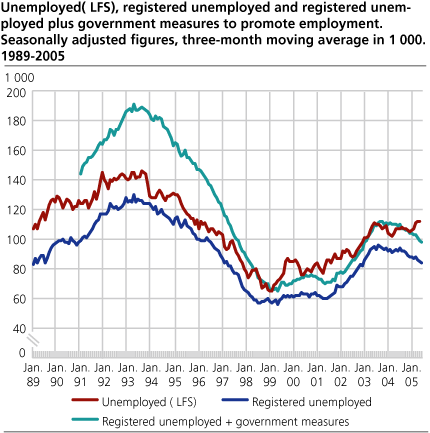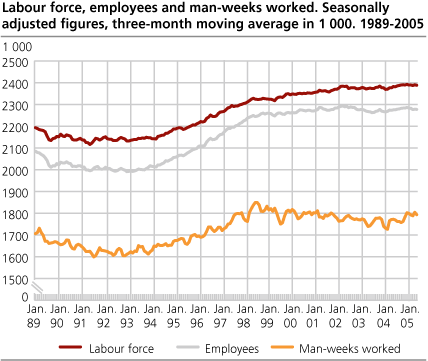Content
Published:
This is an archived release.
116 000 unemployed
The unemployment rate was 4.8 per cent in the second quarter, an increase of 0.2 percentage points from the second quarter of last year. Women accounted for all of the increase. The figures are taken from the latest Labour Force Survey (LFS) carried out by Statistics Norway.
|
Seasonally adjusted figures: Unchanged unemployment Unemployment in May stayed unchanged from the previous month, according to seasonally adjusted figures from the LFS. However, the unemployment rate increased by 0.2 percentage points from the first to the second quarter of 2005. In the same period, there were no significant changes in the number of employees. The seasonal adjustment method is a favourable method of revealing the current development in the labour market, and serves as an alternative to comparisons with the corresponding quarter in the previous year. Seasonally adjusted figures are presented in a separate article. |
The number of unemployed people increased by 5 000 from the second to the third quarter of 2005, to 116 000. The total unemployment rate was 4.8 per cent, the rate for men 5.0 per cent and the rate for women 4.7 per cent. Women accounted for all of the increase, while the figure for men stayed approximately unchanged.
The proportion of long-term unemployed fell from 27 to 25 per cent from the second quarter of last year. Long-term unemployment is defined as unemployment that has lasted for at least six consecutive months.
Fewer in temporary employment
The number of temporary employees was 201 000 in the second quarter of 2005, a decline of 12 000 from the second quarter of 2004. This represents 9.5 per cent of all employees. Temporary employment is most common in the primary industries, health and social work, and education. The manufacturing industries, transport and communication, and public administration and defence have relatively few temporary employees.
97 000 underemployed
The number of underemployed, i.e. part-time employees who want to work more hours, fell from 100 000 to 97 000 from the second quarter of 2004 to the second quarter of 2005. The underemployed represent 15.8 per cent of all part-time employees, compared with 16.1 per cent in the second quarter of 2004. The majority of the underemployed work in health and social work or retail trade. Half of all part-time employees work in these two sectors.
Actual hours worked for the unemployed and underemployed amounted to 136 000 man-weeks (full-time work) in the second quarter of 2005, approximately unchanged from the corresponding quarter of 2004.
Labour force participation slightly down
Total labour force participation fell from 73.0 per cent in the second quarter of 2004 to 72.6 per cent in the second quarter of 2005. The decline was strongest among women, and particularly young women (age groups 16-19 and 20-24).
Increase in wholesale and retail trade
While the total number of employees stayed approximately unchanged from the second quarter of 2004 to the second quarter of 2005, employment increased by 13 000 people in wholesale and retail trade. On the other hand, public administration and defence had a fall in employment of 12 000 people, and women accounted for most of this. The number of full-time employees aged 55-66 increased from the second quarter of last year, while the opposite was the case for part-time employees aged 16-19 and full-time employees aged 20-24.
Fewer in temporary employment
The number of temporary employees was 201 000 in the second quarter of 2005, a decline of 12 000 from the second quarter of 2004. This represents 9.5 per cent of all employees. Temporary employment is most common in the primary industries, health and social work, and education. The manufacturing industries, transportrt and communication, in addition to public administration and defence have relatively few temporary employees.
Overtime equivalent to 68 000 full-time jobs
21 per cent of full-time employees worked overtime in the second quarter of 2005. The figure is 24 per cent for men and 17 per cent for women. The amount of overtime was equivalent to 68 000 full-time jobs, or 4.7 per cent of all man-weeks by employees working full-time. The proportion of people working overtime was highest in financial intermediation (31 per cent), wholesale trade (30 per cent), and oil and gas extraction (29 per cent) and lowest in education, health and social work, in addition to public administration and defence (13-16 per cent).
Tables:
- Table 1. Population aged 16-74 in the labour force, man-weeks worked, registered unemployed persons and persons employed by government measures. 1000 and per cent
- Table 2. Population aged 16-74 år in the labour force, employed persons and unemployed persons by sex (LFS). 1000 and per cent
- Tabell 3. Persons in the labour force and employed persons by age and sex (LFS). 1 000 and per cent
- Table 4. Population aged 16-74, employed persons by settled/usual working hours per week(1) and unemployed persons by age and sex (LFS). 1000
- Table 5. Persons in the labour force by age and sex. 1000 and as per cent of all in each group
- Tabell 6. Employed persons by sex and settled/usual working hours pr week (LFS). 1 000
- Tabell 7. Population aged 16-74 by main activity, part-time employment1 and age (LFS). 1 000
- Table 8. Employed persons by major industry division. 1000
- Tabell 9. Number of man-hours worked per week1, by industry division (LFS). 1 000
- Tabell 10. Employed persons,total, and employed persons at work by status and sex. Number of man-weeks worked1 and actual working hours per week (LFS)
- Table 11. Employed persons and absence from work during the whole survey week by reason for absence and sex(1). 1000 and per cent
- Table 12. Employees with temporary jobs, by major industry division (LFS). 1000 and as per cent of all employees
- Table 13. Unemployed persons by sex and age (LFS). 1000 and per cent
- Table 14. Unemployed persons by duration of job search (LFS). 1000 and per cent
- Tabell 15. Unemployed persons by main activity (LFS). 1 000
- Table 16. Unemployed and underemployed persons, by sex and desired working hours per week. Number of man-weeks (of 37,5 hours) supplied (LFS). 1000
- Table 17. Employment and unemployment for persons aged 16-74 years, seasonally adjusted, three-months moving average. Absolute figures in 1000 and unemployed persons in per cent of the labour force.
- Tabell 18. Persons in the labour force by sex and region (LFS). 1 000 and in per cent of total
- Tabell 19. Employed persons by sex and region (LFS). 1 000
- Tabell 20. Employed persons by sex and regions (LFS) as per cent of all inn each group
Contact
-
Arbeidsmarked og lønn
E-mail: arbeidsmarked@ssb.no
-
Erik Herstad Horgen
E-mail: erik.horgen@ssb.no
tel.: (+47) 93 08 68 62
-
Håvard Hungnes Lien
E-mail: havard.lien@ssb.no
tel.: (+47) 40 90 26 06


